
YouTube 1K Challenge: Ready to get 1000 Subs!
Ready to grow your YouTube channel fast? Join the FREE 1K Challenge and learn proven steps to get your first 1,000 subscribers—straight from Think Media’s experts.
Views feel random… results don’t. Use the exact words people search, open with the promised fix, and place a link where clicks happen. Ship your first conversion-ready video in under 60 minutes with $0 tools.
Recommendations also learn what each viewer likes and surface videos they’re likely to watch. When your content solves a clear problem and keeps people engaged, you ride that momentum into more discovery. That’s how intent becomes traffic, and traffic becomes business. Federal Trade Commission
To convert the moment interest is highest, place your next step where clicks are possible. Use the first line of your long-form descriptions and a pinned comment. Add end screens in the final 5–20 seconds to point viewers to the right destination.
Note that Shorts descriptions and comments don’t allow clickable links, so route Shorts viewers to your channel or a companion long-form.
Quick note: Some sections may include affiliate links. If you buy through them, we may earn a commission. Disclose clearly in-video and near each link to stay compliant.

The Search-Based Play: Why Intent Wins
Search finds need, not noise. Match the phrase, deliver fast, then guide the next step.
YouTube’s search system sorts billions of videos to show the most relevant, useful results to each query.
Your job is to match the wording in the searcher’s mind and deliver. SocialWick
When you align with search intent, recommendations help too. The system learns what each viewer likes and suggests videos they’re likely to watch next. If your video satisfies the query and keeps attention, YouTube shows it more often on Home and Up Next.
Intent turns into watch time, which turns into discovery.
Quick Win: Write your title as the exact question your best buyer would ask, then promise the outcome in the first 10 seconds. Keep it plain. SocialWick
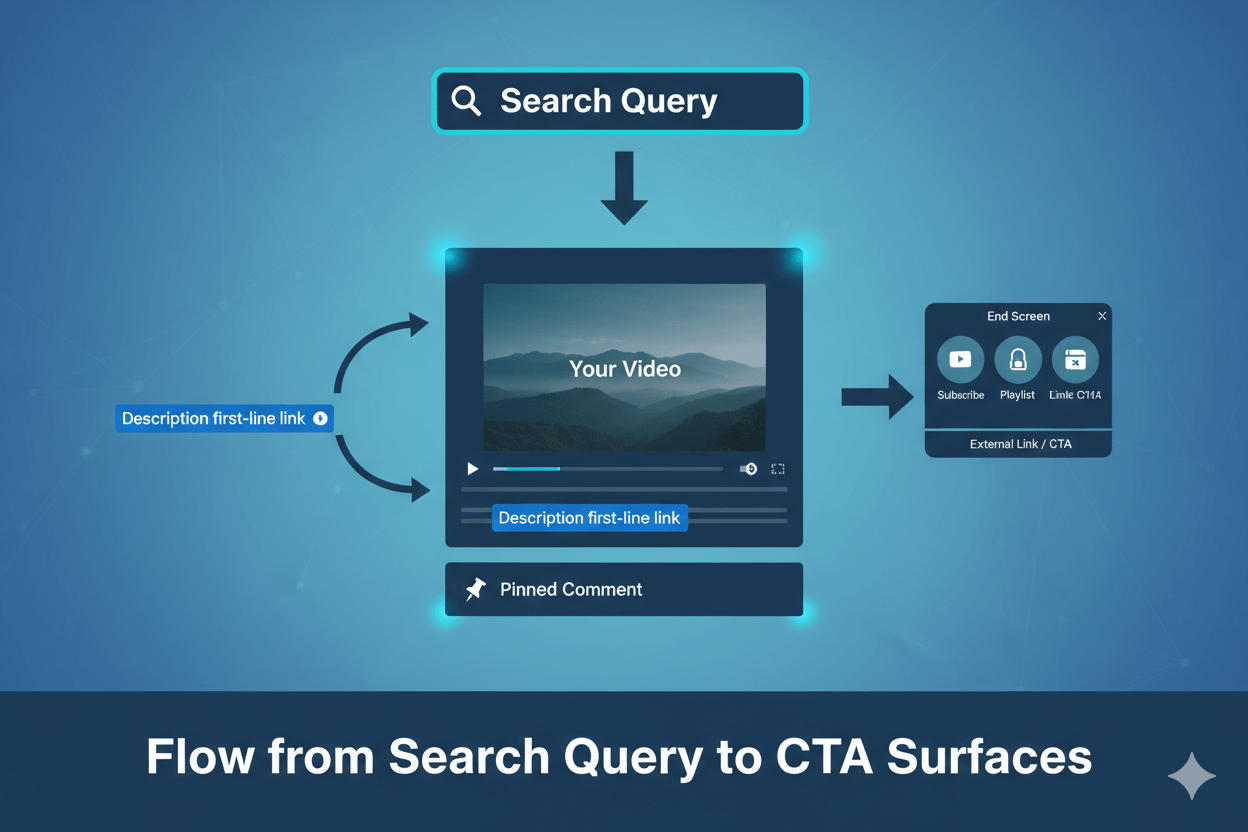
What “intent-driven” means on YouTube
Intent is the reason behind the words. “How to start a podcast on a budget” shows learning intent with purchase potential. “Best budget podcast mic 2025” shows ready-to-buy intent.
YouTube’s search ranking system aims to help people “find what they’re looking for,” so videos that directly solve the task tend to rise. Keep intros short. Show the fix. Name the result.
Two signals matter for staying power: relevance and satisfaction. Relevance comes from your title, description, and on-video delivery matching the query. Satisfaction comes from watch time, likes, and the viewer not bouncing to a different answer.
When both show up, recommendations carry your video further.
Long-tail keywords and buyer signals (examples)
Long-tail phrases are longer, clearer, and closer to action. They trade raw volume for intent that converts. Use them to anchor your scripts and CTAs:
- “Best budget podcast mic under $100 2025”
- “YouTube banner size Canva template”
- “Local realtor YouTube script for first-time buyers”
- “How to add end screens on iPhone”
Build a small list from YouTube Autocomplete and your audience’s “People also search” phrasing. Shape titles that mirror those exact words, then structure the first 30–60 seconds to promise the outcome. Close with a simple next step the moment the viewer feels clarity.
For a deeper primer on how the 2025 ranking environment favors relevance and viewer value, review current algorithm explainers that emphasize match quality and engagement, not tricks. Federal Trade Commission+1
Find The Demand: Research Inside YouTube Studio
Open Studio → Trends → Research. Audience searches hand you titles and scripts in minutes.
You don’t guess. You listen to search… then you build. Open YouTube Studio and start where intent lives: the Trends tab and Research insights.
Here you’ll see what your audience—and viewers across YouTube—are actually typing, plus where content gaps exist that you can fill today.
Use this simple loop: check Audience searches, scan content gaps, test phrasing with Autocomplete, and save winners. Autocomplete reflects real search predictions based on popularity and similarity, so it’s a fast way to pick the exact words your buyers use.
Save terms in Trends to track over time and focus your next upload. YouTube
Research tab and “audience searches” workflow
Go to Analytics → Trends. Explore Searched on YouTube to see recent phrases, and expand Content gaps to find areas with demand but weak or missing videos. These insights vary by country and language, so save terms that match your market and review weekly.
Build titles from the saved phrasing, not guesses.
Then sanity-check the wording in the main search bar using Autocomplete. Note how the suggestions shift as you type; capture the clearest, most buyer-ready variants. Think: “best budget podcast mic 2025” instead of “podcast mic.”
Those longer phrases signal intent and make your opening promise obvious. YouTube
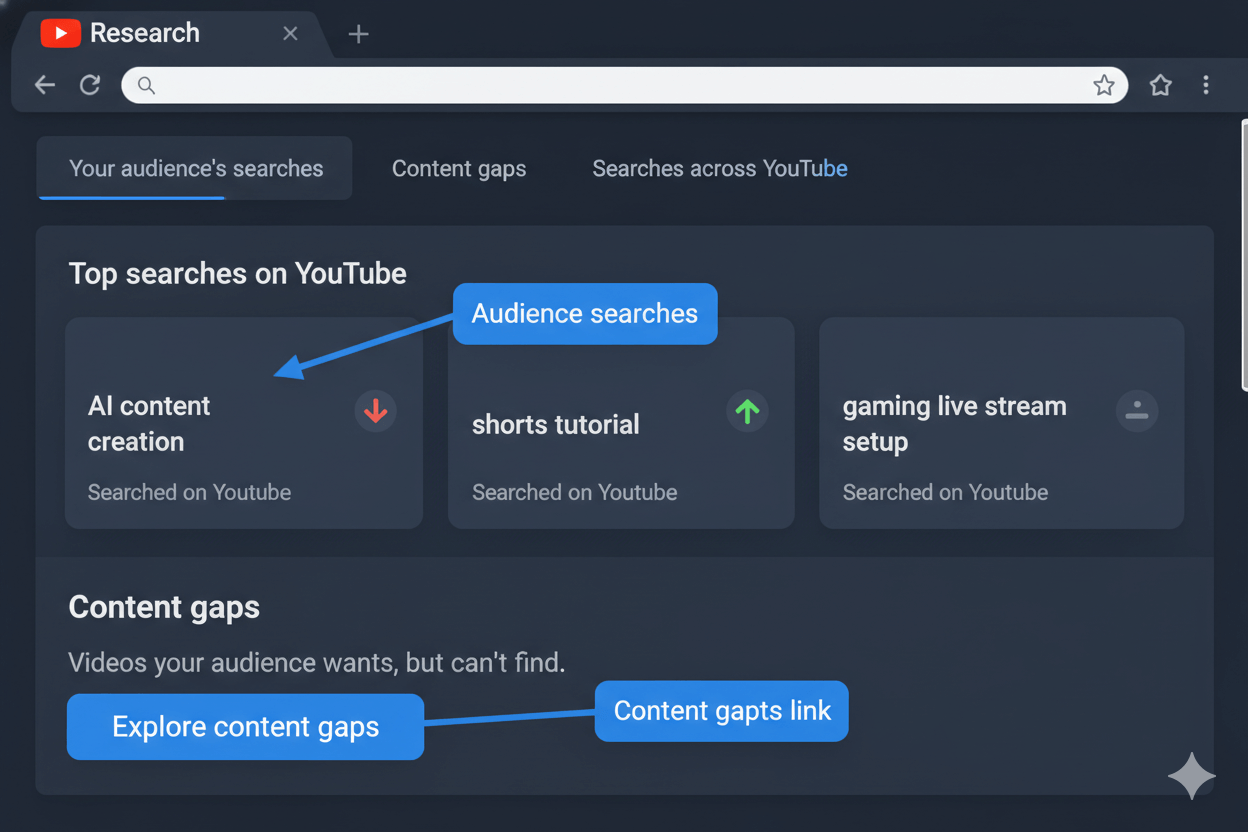
Title A/B and Ask Studio prompts you can use now
YouTube announced Ask Studio and title A/B testing at Made on YouTube 2025. Ask Studio is a conversational assistant that surfaces channel insights and can help ideate angles. Title A/B lets you test versions directly, so you ship the winning phrasing without guessing.
Use both to validate what the Research loop found. Google Help+1
Prompt ideas for Ask Studio: “Show me rising audience searches in [niche] from the last 28 days,” “Suggest three title variants that include [saved phrase] and a clear outcome,” and “Which recent videos earned the highest retention in the first 30 seconds?”
These keep your inputs grounded in intent, not trends.
When you combine Research + Autocomplete + Ask Studio + Title A/B, you turn raw demand into precise titles and hooks that match real queries. That fit makes discovery easier and sets up the conversion work that follows.
Case Study: Sean Cannell’s Search-First System
One phrase, one promise, one next step. Cannell’s pattern is repeatable. You win when your video answers a question someone just typed… not when you chase trends.
Sean Cannell’s play is simple: research the exact phrase, say it back in the title, open fast with the promise, then teach and point to one clear next step.
Cannell’s public content shows keyword-first thinking and plain titles that mirror search. His course materials pitch a system to “rank videos” and “turn views into income,” which you should treat as vendor claims.
What matters for you is the visible method: search a phrase, package the answer tightly, and repeat a consistent CTA.
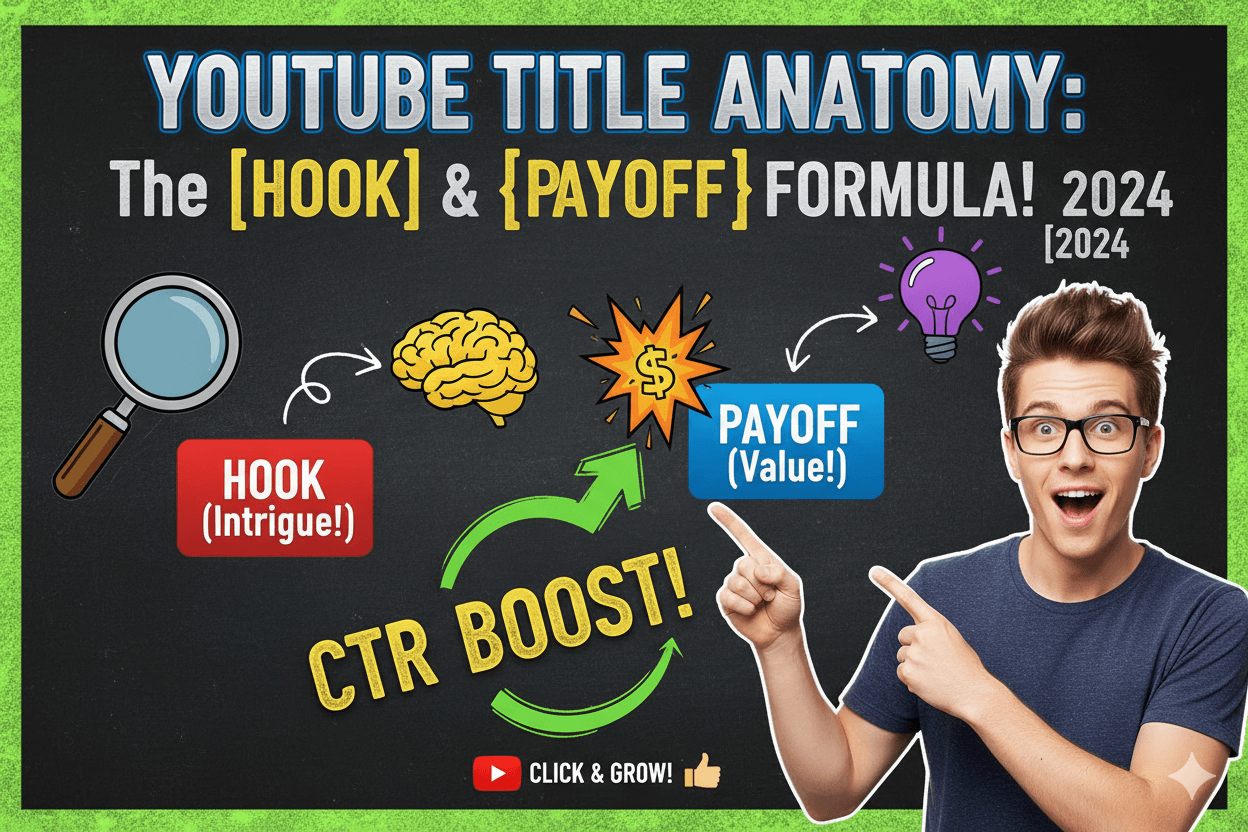
Title and first-30-seconds blueprint
Start with the searcher’s words. If the phrase is “best budget podcast mic 2025,” your title can read: “Best Budget Podcast Mic 2025: Clear Sound Under $100.”
Open by saying the promise out loud and on screen, then show the result in the first 30–60 seconds so viewers know they’re in the right place. Cannell’s keyword-driven tutorials and interviews model this straight-to-the-point cadence and phrasing.
Keep it lean, speak to the outcome, and set up the CTA you will reference later.
Before_After:
Before — “Podcast Mics”
After — “Best Budget Podcast Mic 2025 (Under $100) + Sound Test”
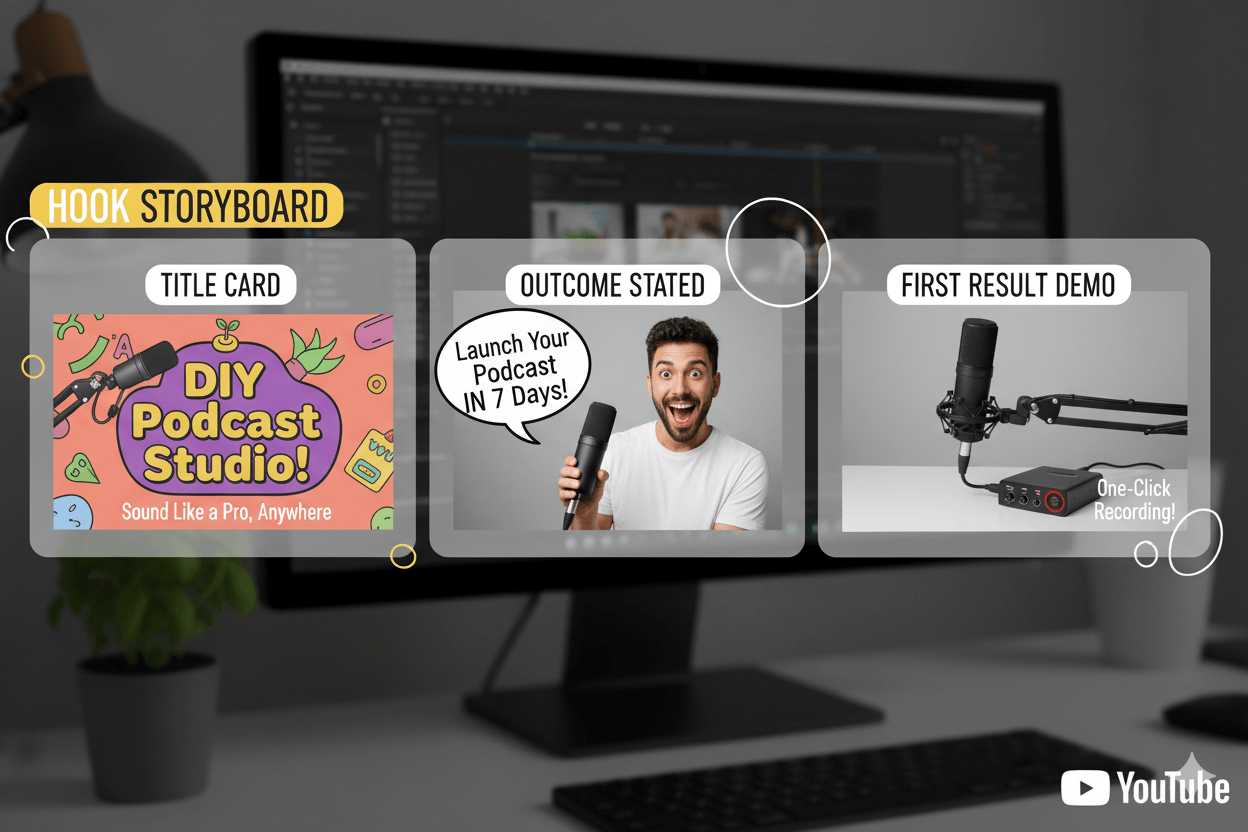
Repeatable CTA placement in every upload
Place your primary link in the first line of a long-form description. Add a pinned comment that repeats the link and reason to click. In the last 5–20 seconds, add end screens to push one logical next step: a review, a tutorial, or a signup video.
Shorts descriptions and comments aren’t clickable, so route Shorts viewers to your channel profile links or to a companion long-form where links do click. Keep all links within YouTube policies.
Practical setup:
- Description line 1: benefit + link.
- Pinned comment: same link, short reason to click.
- End screen: one video or playlist that continues the journey; you can add up to four elements on 16:9.
- Shorts: say “link on my channel” or “watch the full guide” and point to the long-form.
Vendor pages for Video Ranking Academy market outcomes; rely on platform docs and public videos for mechanics. Stay disclosure-clean near each affiliate link and keep your promises specific and observable.
From View to Click: CTA Surfaces That Convert in 2025
Put links only where clicks live: description line one, pinned comment, end screens. Start with the surfaces YouTube confirms as clickable today, then shape your copy for clear, fast action.
Shorts links don’t click, so your long-form video does the heavy lifting for conversions.
Here’s the simple map. On long-form, URLs in the description and in comments are clickable. Use the first line for your main offer, then echo it with a pinned comment.
If you want external links to click, make sure your channel has advanced features enabled. Keep every destination within YouTube’s External links policy.
| Surface | Long-form | Shorts |
|---|---|---|
| Description | Clickable1 | Non-clickable |
| Comments | Clickable1 | Non-clickable |
| End screens | Clickable2 (5–20s; ≤4 elements) | YouTube-only4 |
| Cards | Clickable2 (≤5 cards) | Not supported |
| Channel profile links | Clickable3 | Clickable via profile3 |
- Advanced features required for clickable external links in long-form descriptions and comments; all destinations must comply with YouTube’s External links policy.
- YPP eligibility required for external website linking from end screens and cards; links to YouTube videos/playlists are always allowed.
- Channel profile supports up to 14 links; use for evergreen offers and routing from Shorts.
- Shorts linking: Shorts descriptions and comments don’t support clickable URLs. Use the “Related video” option to link to YouTube content, or route viewers to channel profile links.
Description first line and pinned comment templates
Your description’s first line is prime real estate. Use a plain sentence, benefit first, then the URL. Example: “Get the budget mic I use here → https://example.com/mic.”
Follow with one support line and your disclosure. Pinned comments work on long-form too, so mirror the link and add a short reason to click.
Enable advanced features so external links in comments/descriptions become clickable for viewers. Keep URLs clean and readable.
Template you can swipe:
- Line 1 (benefit + link): “Grab the checklist I mention here → https://example.com/checklist”
- Line 2 (context): “It covers gear links, settings, and the script.”
- Pinned comment: “Checklist link above. Saved creators 2+ hours editing this week.”
Add a clear disclosure near each link and again in-video.
End screens and cards that point to approved next steps
End screens live in the final 5–20 seconds and can show up to four elements on 16:9. Use one logical next step: most-relevant video, a playlist, subscribe, or an external site if you qualify.
External website linking on end screens requires YouTube Partner Program status and policy compliance.
Cards can appear during the video. You can add up to five and point to a video, playlist, channel, or, if you are in YPP, to an approved external website. Place cards only where the viewer benefits from a quick branch, not throughout the whole video.
Keep the journey focused so the click is intentional.
Final guardrails: Never link to destinations that violate YouTube’s rules. When in doubt, check the External links policy and keep CTAs value-first. Google Help
Shorts → Long-Form → Link: Routing That Works
Shorts spark, long-form closes. Build the bridge on purpose. SocialWick
Shorts spark interest. Long-form closes the loop. Build a clean path: Short → channel profile or companion long-form → description first-line link and pinned comment.
Because URLs in Shorts descriptions and comments don’t click, you guide viewers to the places that do.
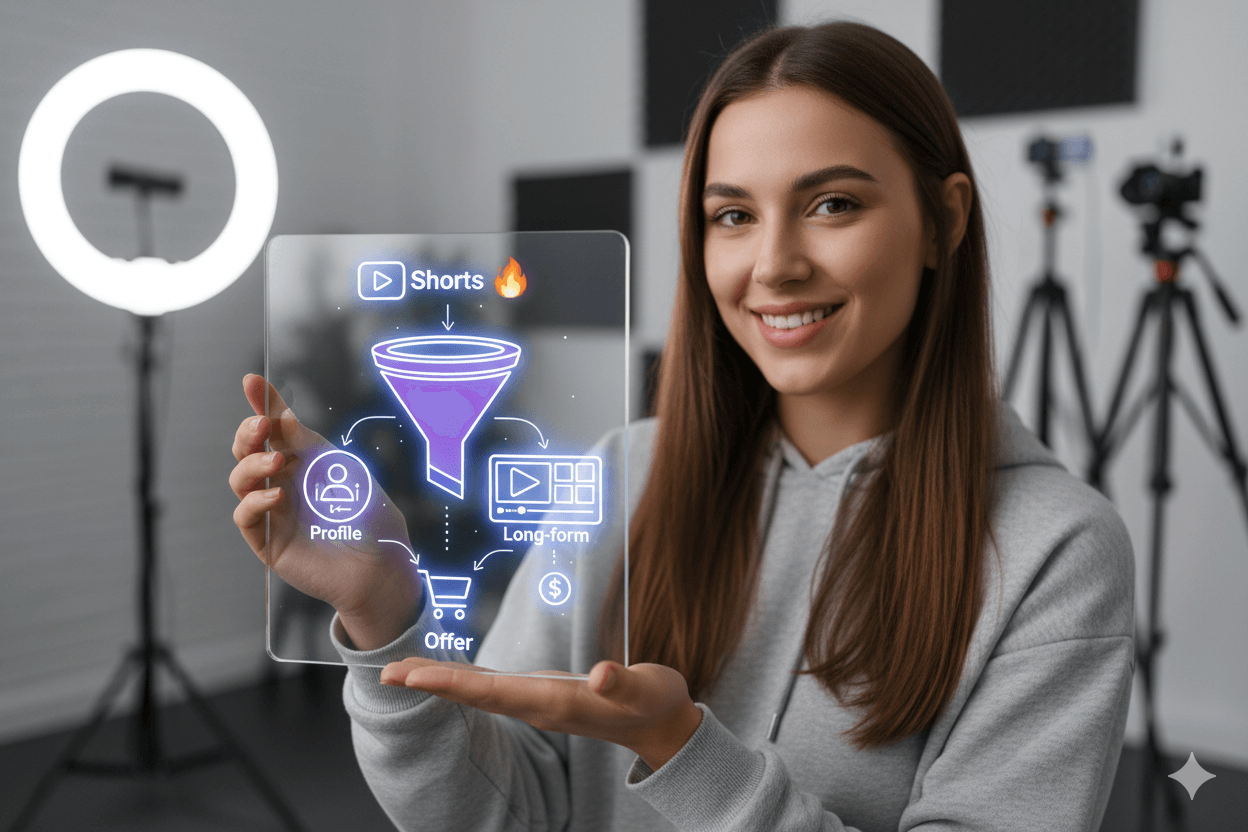
Pro_Tip: Record the Short as a teaser for one specific long-form video. Say the destination out loud: “Watch the full guide on my channel.” Keep the path single and simple.
Channel profile links setup and ordering
Your profile can showcase up to 14 links on the Home tab. The first link appears next to the subscribe button, while the rest expand under “More links.” Use that first position for your primary offer or evergreen lead magnet.
Keep link text short and clear so it’s easy to recognize on mobile. All links must follow YouTube’s external links policy.
Setup steps are quick: open Customize channel → Basic info → Links, add your URLs, and drag to reorder. If you publish frequent Shorts, reference the profile verbally and on-screen: “Link on my channel.”
This gives viewers a reliable route to a clickable destination even when the Short itself can’t carry live links.
Companion long-form structure and end screen handoff
Design one long-form video to receive your Shorts traffic. Front-load the promised result in the first 30–60 seconds so viewers feel they arrived in the right place. Put your primary CTA in description line one, then echo it via a pinned comment.
This keeps the next step visible for both desktop and mobile viewers.
Add end screens in the final 5–20 seconds. You can show up to four elements on 16:9, such as the exact next tutorial, a playlist, or subscribe.
If you qualify for external linking, you can direct viewers to an approved site; otherwise, keep the chain inside YouTube and let your description handle off-platform clicks.
Viewers now have the option to hide end screen overlays during playback. In testing, YouTube reported a small impact on end screen clickthroughs after adding a “Hide” button.
This makes redundancy essential: repeat the CTA in your description and your pinned comment so your path survives viewer controls and still converts.
When this route is in place, each Short becomes a steady on-ramp. Curiosity starts the journey, clarity keeps attention, and your long-form page—title, first-line link, pinned comment, and end screen—does the careful work of turning views into results.
Track the Money: UTM + GA4 Basics
In GA4, Traffic acquisition tells the revenue story at a glance.Tag every off-YouTube link, then read the results in one place. Use simple, consistent UTM tags so GA4 groups your traffic correctly and lets you compare views, sessions, and conversions by campaign
…without guesswork.
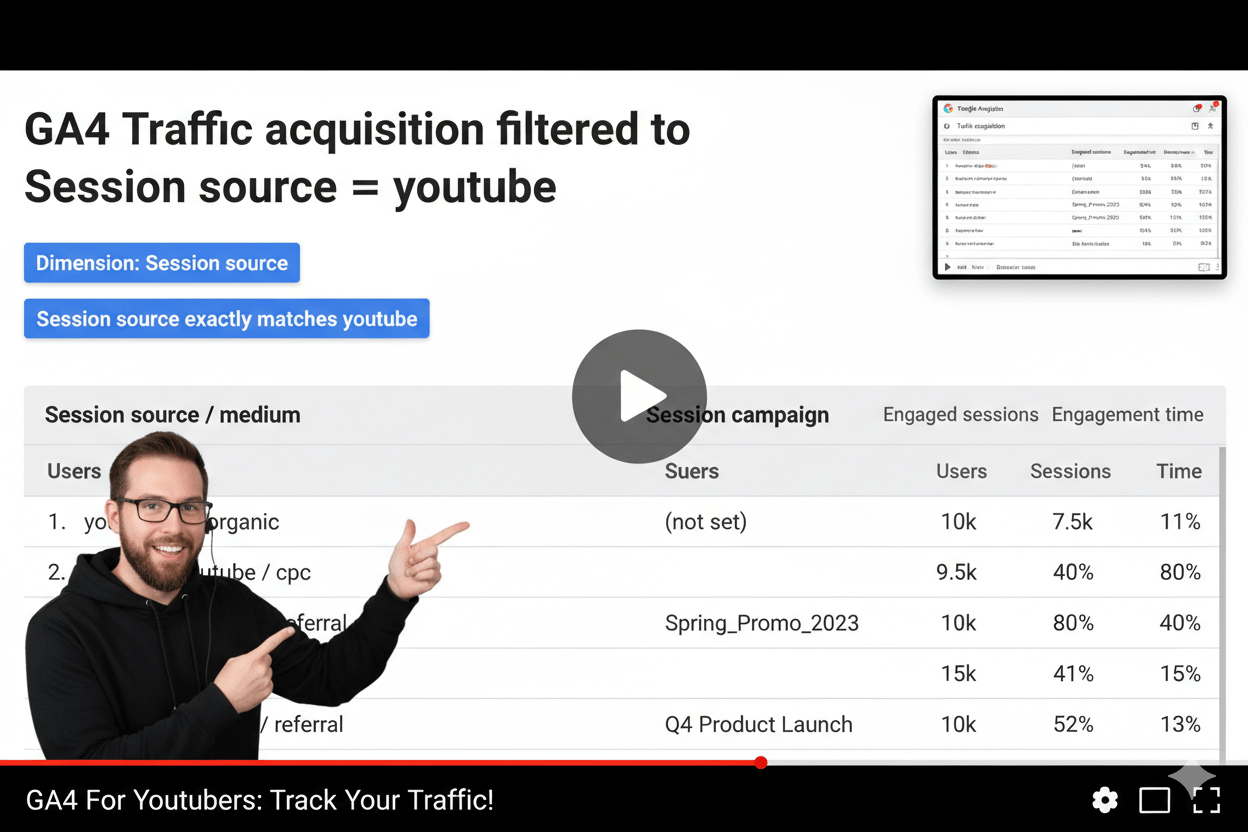
Build clean UTMs for YouTube
Use Google’s Campaign URL Builder or add parameters manually. GA4 accepts many utm_* keys. Google advises you “should always use” utm_source, utm_medium, and utm_campaign.
GA4 works with any one UTM, yet those three keep reports readable and comparable. GA4 treats values as case sensitive, so pick lowercase and stick to it.
Starter pattern you can reuse:
utm_source=youtubeutm_medium=video(orshorts,live)utm_campaign={video-keyword-or-offer}- Optional:
utm_content={variant}for A/Bs
Example:https://example.com/offer?utm_source=youtube&utm_medium=video&utm_campaign=best-budget-podcast-mic&utm_content=desc-firstline
Keep UTMs off internal links on your site. Internal tagging breaks attribution and inflates direct traffic in later sessions. Maintain a small spreadsheet so titles, campaigns, and casing stay consistent across your team.
Place tagged URLs where clicks happen: description line one and a pinned comment in long-form, then repeat the reason to click. Add a short, plain disclosure near each affiliate link to stay compliant.
Read campaign results in GA4
Open Reports → Acquisition → Traffic acquisition. This report answers “which sessions came from each source, medium, and campaign.” Use Session source/medium and Session campaign to see performance for your YouTube links.
GA4’s User vs. Traffic acquisition explains the scopes: User focuses on first-touch, Traffic focuses on each session. For link tracking, Traffic acquisition is the workhorse.
Quick workflow:
- Filter Session source to
youtubeor search foryoutube / video. - Add Session campaign as a secondary dimension to compare offers and videos.
- Review engagement, key events, and conversions by campaign.
- If a report is missing, add it from the Library, then save your view.
Two useful notes from Google’s docs: UTM parameters appear in campaign dimensions, not in “Landing page + query string,” so check Page location if you need the full URL context; and GA4 also supports campaign fields via Tag Manager or gtag if you must set values programmatically.
When every link is tagged and every report is filtered, you see the money trail clearly. That clarity lets you double down on the videos and offers that win… and cut the ones that don’t.
Templates That Ship: Titles, Descriptions, Pins, End Screens
Copy, paste, customize… and publish in under 30 minutes. You want speed. You want words that match the searcher’s brain… then a gentle nudge to click. Use these swipes to draft in minutes and publish with confidence.
Keep disclosures clear and close to each link. Keep every destination on-policy.
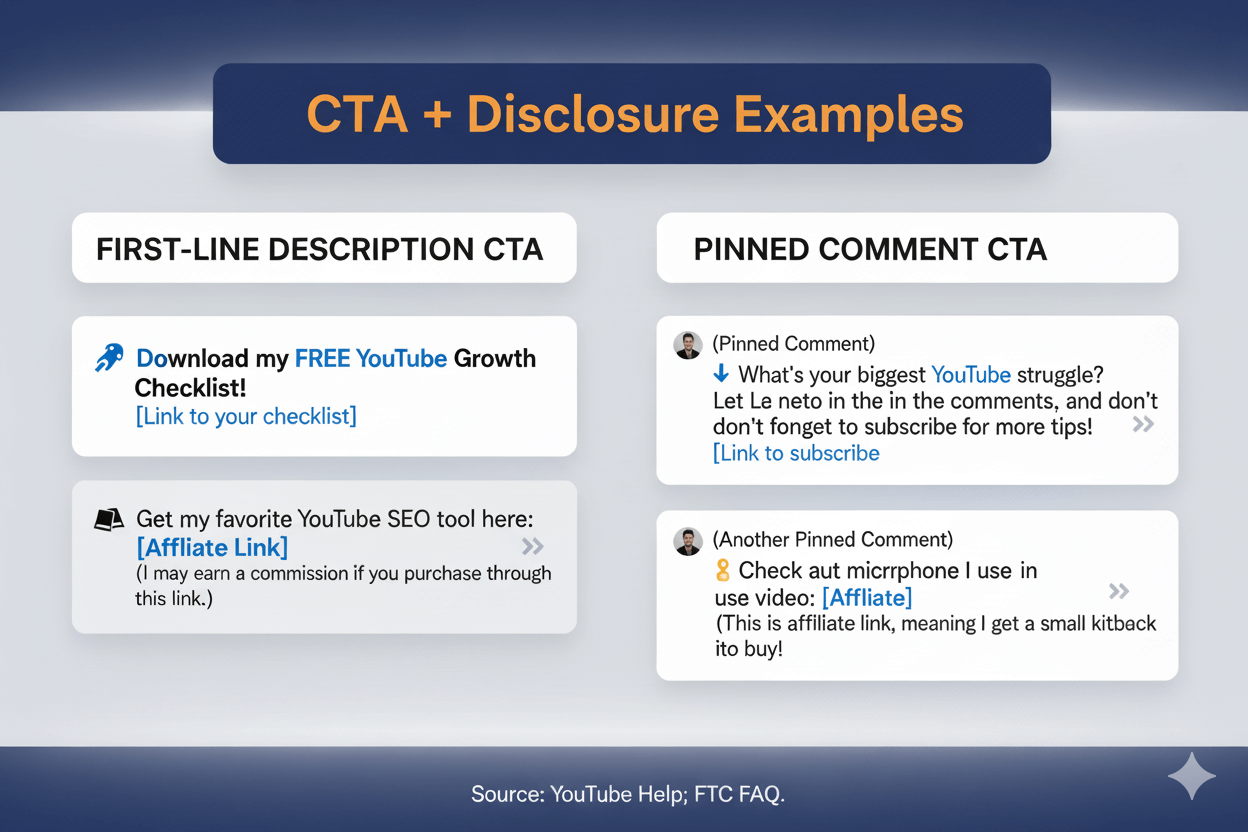
Title and CTA swipes for reviews and tutorials
Review title swipes
- “Best [product] [year]: [result] on a budget”
- “[product A] vs [product B] [year]: Which is right for you?”
Tutorial title swipes
- “How to [task] in [tool] ([year] quick start)”
- “[result] in 10 minutes: [task] for beginners”
Description line 1 (benefit + link)
- “Get the [gear/checklist] I use → https://example.com/offer”
- “Start your [free tool/trial] here → https://example.com/start”
Pinned comment
- “Link above. It includes [what they get]. Saves you [time/money].”
Disclosure (place immediately under each link)
- “If you buy through my link, I may earn a commission.”
This satisfies the FTC’s call for clear and conspicuous disclosures that are easy to notice and understand. Keep the wording plain. Put it close to the link and also state it in your video.
End screen copy
- “Next: [related tutorial]”
- “Watch to finish your setup”
End screens appear in the last 5–20 seconds and can show up to four elements on 16:9. Choose one logical next step. Google Help
Where links actually click
- Long-form descriptions and comments: clickable.
- Shorts descriptions and comments: not clickable. Route to profile or a companion long-form. Google Help
Pin vs. description test plan
Run a simple 28-day experiment across four uploads:
Setup
- Video 1–2: Primary CTA in description line 1. Pinned comment repeats it.
- Video 3–4: Primary CTA in pinned comment. Description line 1 repeats it.
Keep constant
- Same destination URL with UTMs (e.g.,
utm_source=youtube&utm_medium=video&utm_campaign={video-keyword}) so reports align. Track sessions and conversions in GA4 → Reports → Acquisition → Traffic acquisition.
Measure
- Clicks from description vs. comments (landing-page analytics).
- End-screen CTR to the same destination or bridge video. Google Help
Decide
Pick the surface with the higher conversion rate, then standardize your template. Keep your disclosure near each link every time.
| Surface | Long-form | Shorts | Notes |
|---|---|---|---|
| Description | ✓ | ✕ | Long-form descriptions support clickable external links (ensure channel Advanced features are enabled and destination complies with policy). Shorts descriptions do not allow clickable URLs. |
| Comments | ✓ | ✕ | Creator comments on long-form can include clickable links. Use a pinned comment for visibility. Shorts comments do not support clickable URLs. |
| End screens | ✓ | ✕ | Shown in the final 5–20 seconds; up to 4 elements on 16:9. External website linking from end screens requires YPP eligibility and policy compliance. |
| Cards | ✓ | ✕ | Up to 5 cards per video. External website linking from cards requires YPP eligibility and policy compliance. Use sparingly at key moments. |
| Channel profile links | ✓ | ✓ | Channel profile can showcase up to 14 links. Reliable route from Shorts: tell viewers “Link on my channel.” Keep link text short and clear. |
Source: YouTube Help guidance on link surfaces, end screens, cards, Shorts link behavior, and channel profile links. Ensure all external links follow YouTube’s External links policy and applicable disclosure rules.
Risk Management: Policies, Link Hijacking, and Claims
Keep links on-policy, disclosures visible, and attribution verifiable. Keep your links clean, your disclosures clear, and your attribution tight. YouTube bans links that lead to rule-breaking sites and notes that some links may not be clickable.
Shorts descriptions and comments do not click, so route viewers to places that do. Disclose each material connection in plain language.
| Policy area | Action (how to stay compliant and effective) |
|---|---|
| External links (YouTube) | Link only to destinations that comply with YouTube’s External links policy and Community Guidelines. Put the primary link in the first line of the long-form description; repeat it in a pinned comment. Use end screens/cards to approved sites only if eligible; keep one logical next step. If links aren’t clickable, enable Advanced features and re-test. |
| Shorts link limits | Understand that URLs in Shorts descriptions and comments are not clickable. Route viewers to channel profile links or a companion long-form video where links do click. Say the destination aloud and on-screen to guide the path. |
| Disclosures (FTC) | Place clear, conspicuous disclosures near every affiliate/sponsor link and state it in-video. Use plain language in the same language as the content (e.g., “If you buy through my link, I may earn a commission.”). Repeat the disclosure in the pinned comment when you repeat the link. |
| Attribution hygiene | Append UTM parameters to every off-YouTube URL; standardize utm_source, utm_medium, utm_campaign. Use affiliate network subIDs or unique coupon codes to reconcile payouts. Consider vanity redirects with server-side click logs; run periodic spot checks and reconcile with partner dashboards. |
| End screens | Add in the final 5–20 seconds; up to four elements on 16:9. Choose one next step; viewers can hide overlays, so duplicate the CTA in description and pinned comment. |
| Cards | Limit to ≤5 per video; place only at moments where a quick branch helps. Avoid clutter; keep the journey focused on one outcome. |
| Channel profile links | Showcase up to 14 links; put the primary offer/evergreen lead magnet first. Use short, clear labels for mobile readability. |
| Advanced features | Enable Advanced features to allow clickable external links in long-form descriptions and comments. Verify status if viewers report non-clickable links; re-publish if needed. |
Sources: YouTube Help (External links, Shorts link behavior, end screens, cards, profile links, Advanced features); FTC Endorsement Guides & FAQ.
Policy checklist before publishing
- External links. Only link to destinations that follow YouTube rules. If a site violates Community Guidelines, do not link to it. Some links are non-clickable by design.
- Clickable surfaces. Use long-form descriptions and comments for live links. Shorts descriptions and comments are not clickable. Channel profiles can showcase up to 14 links.
- End screens and cards. Add end screens in the last 5–20 seconds. You can show up to four elements on 16:9. External linking from these surfaces requires eligibility and compliance.
- Advanced features. If viewers say your description links don’t click, enable advanced features for the channel to allow clickable externals in long-form.
- Disclosures. The FTC calls for “clear and conspicuous” notices that are hard to miss and easy to understand. Match the format: say it in the video, show it on-screen, and place it next to each link in the description or pinned comment. Federal Trade Commission+1
do’s_and_don’ts:
Do keep link text clear and destinations trustworthy. Do restate disclosures near each link. Don’t promise earnings. Don’t mask URLs.
Attribution hygiene for affiliates
Browser extensions can interfere with attribution. Multiple outlets report lawsuits claiming coupon extensions replace creators’ affiliate cookies or links, diverting commissions. Treat this as a live risk and build redundancy.
Practical safeguards:
- Unique codes. Where possible, pair links with creator-specific coupon codes to cross-check payouts.
- UTMs + subIDs. Append UTMs for analytics and use network subIDs to tag video, surface, and date so partner dashboards match GA4.
- Vanity redirects. Use short, memorable links that 301 to the affiliate URL. Log clicks server-side to compare against network reports.
- Spot checks. Run test purchases in private browsing with and without popular extensions enabled. Save evidence.
- Escalation path. If discrepancies appear, pull logs and contact the network. Watch evolving cases around Honey and Capital One Shopping for context and possible platform changes. YouTube+2Lifewire+2
Write claims you can prove. Keep every link on-policy. Place disclosures where eyes land first. That discipline protects your revenue and your reputation… every time.
Conclusion
You have a repeatable path. Start with search intent, use the exact words people type, and open with the promised fix. That alignment wins discovery and sets up every conversion surface that follows.
Place your primary link in line one of long-form descriptions, mirror it with a pinned comment, and close with end screens in the final 5–20 seconds.
Shorts create curiosity, so route viewers to places where links click. Feature your evergreen offer in channel profile links and point Shorts to a companion long-form that carries your first-line link and a clear next step.
Keep every destination within policy and enable advanced features so external links work as intended.
Track the money trail. Append simple, consistent UTMs to each link and read results in GA4’s Traffic acquisition reports. Compare campaigns by session and conversion to see which videos and surfaces perform best
… hen ship more of what works. Troutman Pepper Locke
Stay disclosure-clean. Use clear, conspicuous language near every affiliate link, say it in-video, and keep phrasing easy to understand. That protects trust and keeps your program durable. Federal Trade Commission
You now have the playbook: research with Studio, title with intent, teach fast, and place compliant CTAs where clicks are possible. Run it for 30 days. Publish eight search-based videos with companion Shorts, track every link, and review weekly. Small, steady wins stack into real revenue… one precise query at a time.




